Joint Seismic/EM Study of Goban Spur Rifted Margin
Steven Constable,
Ocean basins form when continents break up and rift apart, allowing mantle rock
beneath the crust to rise up between the continental margins, melt, and form new oceanic crust.
When there is abundant melting, this process looks like the formation of oceanic
crust at mid-ocean ridges. However, in some "magma poor" margins, the continental
crust thins by faulting and exposes the mantle rising up beneath the crust
to water penetrating down faults. When combined with water, mantle forms a rock called
serpentinite, rich in hydrated talc minerals and magnetite, a magnetic and
electrically conductive mineral. Serpentinized mantle is also more porous than
lower crustal igneous rocks, making it more conductive.
We wish to understand more about the process
of rifting, but the seismic method, the most commonly used geophysical tool,
has trouble differentiating between lower crustal rocks and serpentinized mantle.
Electromagnetic (EM) geophysical methods allow us to image the electrical
conductivity of the crust and mantle, and this project will use a combination
of seismic methods and EM methods to study a magma poor margin southwest of the UK.
From this we will gain a better understanding of the fundamental tectonic, chemical,
and thermal history of continental breakup.
This is a collaboration between Gaye Bayrakci and
Tim Minshull in the UK and Steven Constable
from Scripps, jointly funded by
the National Science Foundation and the Natural Environment Research Council.
Here's an attempt to explain to a non-scientist what we do (4.7 Mb pdf)
Cruise Report (4.9 Mb pdf)
JC25 cruise report.
Below is a map of our planned work. We will deploy 49 instruments on each of two lines. This is the first
truly integrated seismic and EM experiment: All the Scripps ocean-bottom EM (OBEM) instruments have seismic hydrophones and
all the UK ocean-bottom seismometers (OBS) have electric field sensors, and some of them have magnetometers too.
After deploying the instruments on the first line we will tow an EM transmitter down the line, and then tow a
seismic airgun array. All instruments with magnetometers will also record passive MT data (see "what we do").

Steve's blog (latest entries on top):
Wednesday September 27.
All done! We tied up yesterday morning, greeted in Southampton by low dark clouds and a brief rainstorm. Offloading went quickly
while Gaye and I walked Tim through all the data we had collected. In the evening we retired to a pub for a post-cruise party. Today
I will have lunch with Martin Sinha, father of the original DASI instrument built way back in 1987, and then take a train to London to
start the journey home. See you all next cruise.
The OBIC team (Ben, Anna, Tom, Rafael) getting their land legs:
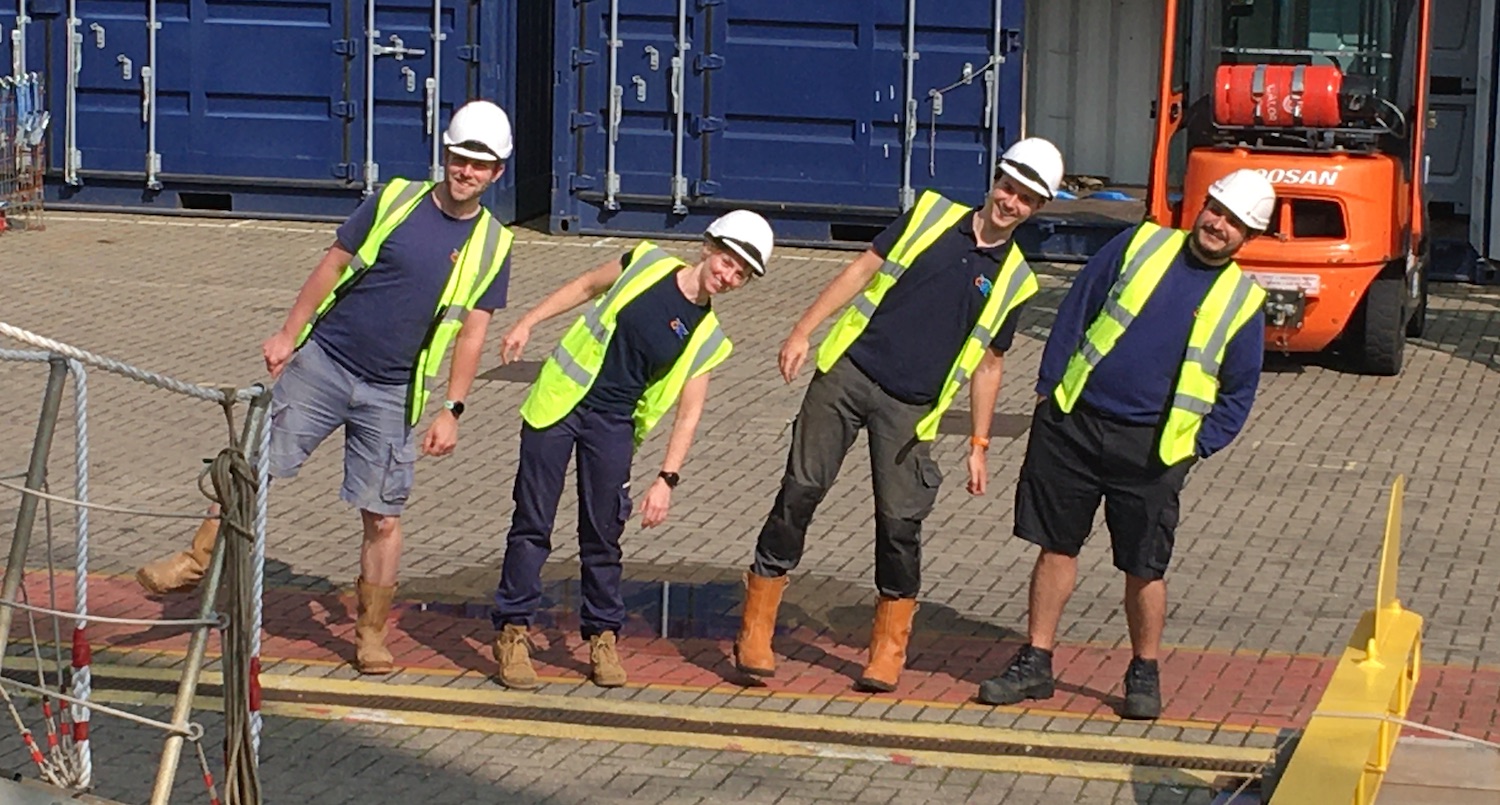
Sunday September 24.
Taking advantage of the miraculous weather window, the PAP buoy was successfully recovered without drama and secured to the deck.
This has earned us the right to come in a day early! But meanwhile the weather has reverted to norm and we must roll around
in high seas collecting surface magnetometer data and bathymetry. I got up this morning and discovered that the lab we have been
using for instrument checkout is taking on water. The life aquatic!
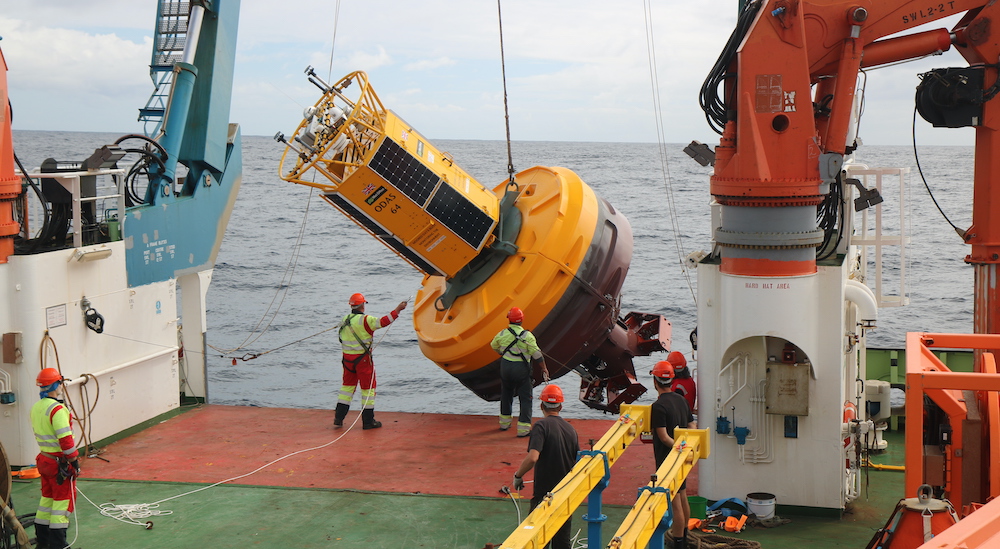
Friday September 22.
People on shore have been asking us for some time now to go and recover something called the PAP buoy. Yes, terrible name but
it stands for Porcupine Abyssal Plain. It had broken loose from its mooring some time ago
(I guess I'm not the only one using bad rigging) and has been drifting, sending its position home by satellite. So, last night after
finishing up the magnetometer tow we headed south to find the buoy. Miraculously, the weather is a lot better than yesterday, and
while there is still a significant swell running, the wind has died down and there is a chance at recovery. Stay tuned. Meanwhile
here is a picture of the offending buoy, and Gaye making an attempt at recovery.
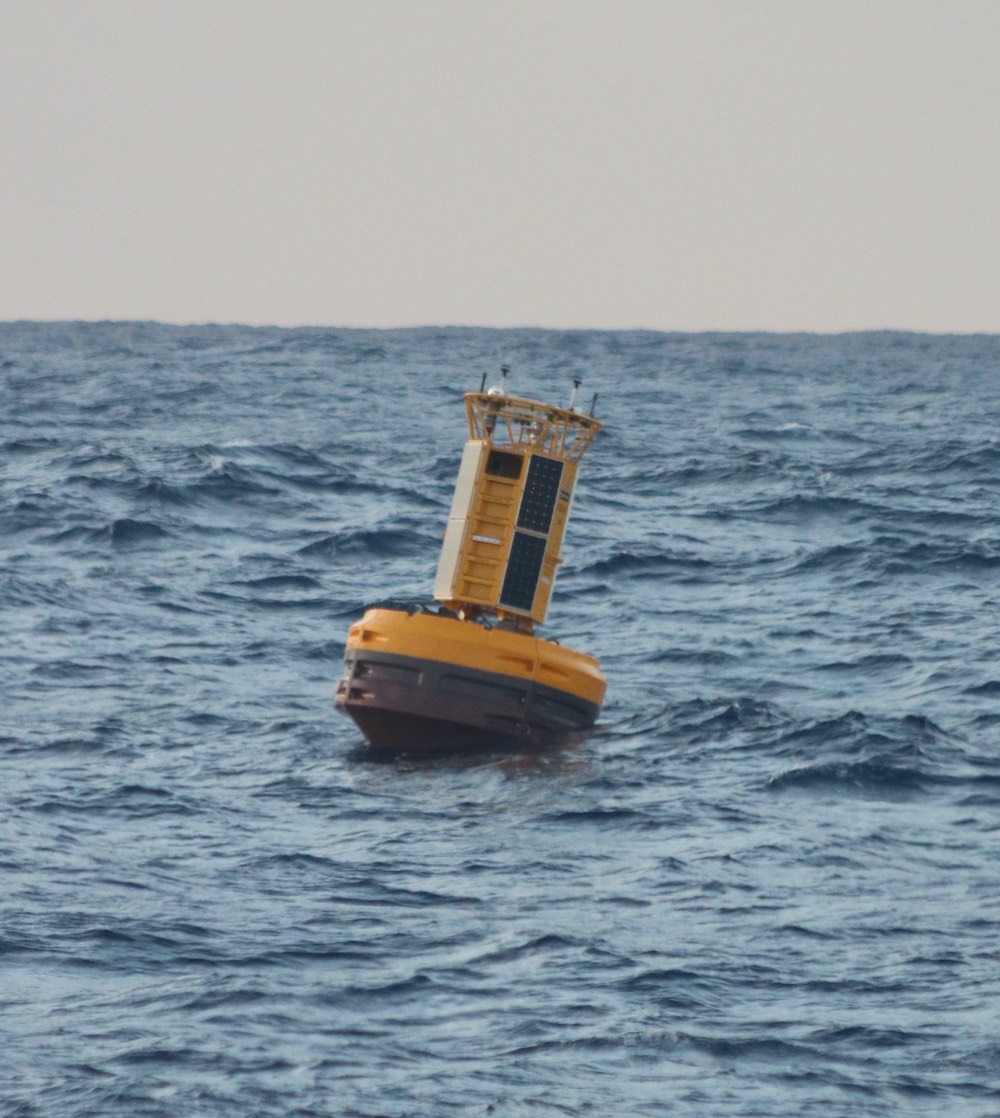 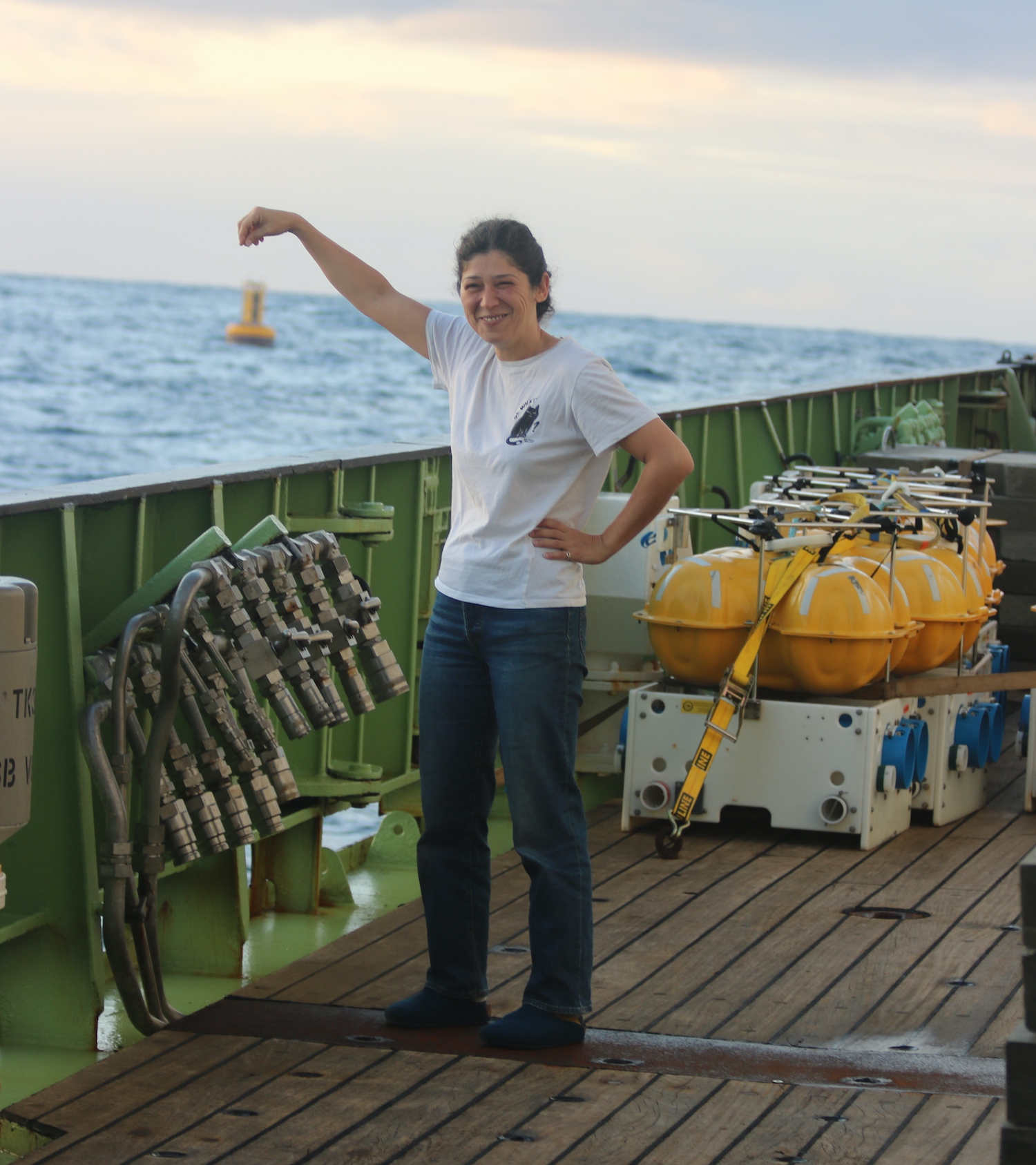
Thursday September 21.
Bad news. Very bad news. Awful news. Yesterday we flew the LEM launcher and magnetometer down to full ocean depth, a five hour process, and had about an hour
of data collection about 300 m above the seafloor when the depth telemetry, which had been working wonderfully well up to now,
stopped sending data. We tried a few things but had to admit that the telemetry bottle had died somehow. I suspected a bad battery in the rechargeable
packs we had installed. There was nothing to do but bring it back on deck, another 4 hours of winch work. Then we set up on deck to put
tag lines on the LEM launcher (the weather was still quite lively), and when the end of the cable made it to the surface that's all there was. The
end of the cable. Everything had dropped off. The guilty remains of the offending shackle, minus the shackle pin, was still attached.
Don't ever use a shackle with a screw-in pin on a deep tow - I had seen John Hildebrand drop his prized seafloor gravimeter off a cable
just this way in 1988. No amount of wire seizing will stop the pin being worked out by the repetetive motion of cable. We have lost
a large amount of expensive equipment, but perhaps the worst loss is a bag of polystyrene cups that had been decorated by our people
and sent down to get shrunken (see the polystyrene heads on the SERPENT blog).
I suppose I
should have recorded the event with a photo, but I was too sick at heart. Instead I will give you another picture of pilot whales in the Alaska
cruise tradition of looking at harmless whale photos when things go wrong.

Having lost the deep-towed maggie and having nothing better to do we spent Thursday rocking and rolling in some of the worst weather we have had so far and collecting magnetometer data (maybe useful) and
bathymetry (completely useless because of the weather). I am most grateful for the excellent roll stabilization on this vessel.
Wednesday September 20.
This has been a very frustrating few days. The really bad weather that was forecast didn't arrive yet, but it has been
too rough to do much and the future forecasts always tend to remain scary. Gaye has been really keen all cruise to shoot the airguns into
a submarine cable that her colleagues have rigged up to record seismic signals (using DAS, or Distributed Acoustic Sensing if you are in
the know). This doesn't require the deployment (and, importantly, recovery) of seafloor instruments, and would be a novel experiment.
But, most of the cable is outside the area that has been permitted for our work, and extending the permit entails 6 week of
bureaucracy. She managed to start shooting Monday morning in international waters after the required 1 hour of marine mammal survey,
but concern about the weather meant that the guns were recovered after only 1.5 hours of shooting. There is a floating mooring
that people on shore would like us to recover, but the weather we would need to do that is not forecast until after we are due to tie up.
So all we can do is tow a surface magnetomter around and collect fairly crummy (because of the ship's motion) bathymetry data. Hardly
worth the salaries and diesel. However, "no-one has ever returned early before" so going home is not on the cards. I'm sure the several
people that are feeling sea-sick would hope for more flexibility, and quite a few others who are not sick are having trouble sleeping through the
rocking and rolling.
But, yesterday I realized that the weather has remained just on the right side of workable, so I proposed that we re-deploy our new deep-towed
magnetometer from behind the LEM launcher. We had towed it behind DASI, but a technical problem prevented the logger
from recording.
There is still concern that the forecast for Thursday is bad, but we got permission to give it a try. We swapped out the logger with
one from the recovered instruments and gave it
a bench test, and the LEM launcher and maggie went out through the A-frame this morning in a fairly routine and un-exciting deployment. Fingers crossed that the weather will stay
good enough for the ship to hold course along our line for the next two days.
Sunday September 17.
The last instrument landed on deck at around 11 pm. It has been quite a marathon of recoveries - 6 days for 51 instruments.
We have a second instrument that refuses to talk or release, so with the previous SIO and OBIC ones that's three losses. That's
a lot more than average for a single cruise, but not too bad if you look at the long term average. There's still a chance that the
two Scripps instruments released early and will wash up somewhere.
The cooks are doing a fine job of keeping us fed. Sometimes I wonder how they manage it - at home a pear is ripe
for maybe 2 days, but we've had perfect pears for over two weeks into the cruise. I have been enjoying the British
food of my youth - beans on toast, steak and kidney pud, kedgeree, bread pudding, smoked fish pie, trifle, etc.
As usual, we have brought along our coffee machines and many pounds of boutique coffee (see the blog from the Alaska
cruise), but you know you are on a British ship when the tearoom stocks 3 kg bags of tea.
Saturday September 16.
Dear reader, you may have been wondering what we are up to. Instrument recoveries. It is a slow business, but fairly intense.
We are releasing batches of 3 or 4 instruments trying to space the recoveries about an hour apart, to give us
time to approach, grapnel, hook into the crane, and bring them aboard. Then we need to take them apart, removing magnetometers,
electrode arms, release mechanisms, and cables. And download the data and check for quality. I initially moved to the midnight shift
to help Chris and company. We chugged along for three days recovering at a rate of about 3 hours an instrument. We were hoping for 2
hours each, but I've mentioned the mismatch in rise rates between the Scripps and OBIC (OBS) instruments, and other things happen too.
One of the Scripps instruments failed to respond to release commands. It was replying to pings earlier in the cruise but no longer.
It either has had a catastrophic failure (flooded acoustics or implosion of glass balls), or has risen early on its own and drifted
away.
We got to Thursday with 26 instruments on deck but then had to stand down at 9 pm because, based on forecasts, the weather was going
to get bad very fast. We didn't know how bad, and it could be really unfortunate to have 2 or 3 instruments coming up and weather too
fierce to bring them on deck. So we took a night off. It was actually a welcome break, but by Friday morning we realized that while
not very nice (30 knot winds, 3 m waves), the weather was good enough to continue working. Moreover, the long range forecast was for
40 knot winds and 6 m waves in less than a week's time. So we've been chugging away, spacing the instruments out a bit longer, and taking our
time to bring them alongside the ship, but recovering them safely all the same. There have been a few moments of drama. There have
been a couple of arms broken on recovery (the instrument's, not people's) and one of the OBS
instruments is talking to us but not leaving the seafloor. One of the Scripps instruments came up at night without a flashing light,
but the moment we turned the spotlight on it showed up right next to the ship. Better to be lucky than smart. I am trying to help both shifts now, catching some sleep
between batches of recoveries.
During one recovery we had a pod of what I initially took to be dolphins hanging around at the bow, as dolphins do, but I am told
these are pilot whales. Large blowhole and no pointy nose. Characteristic dorsal fin.
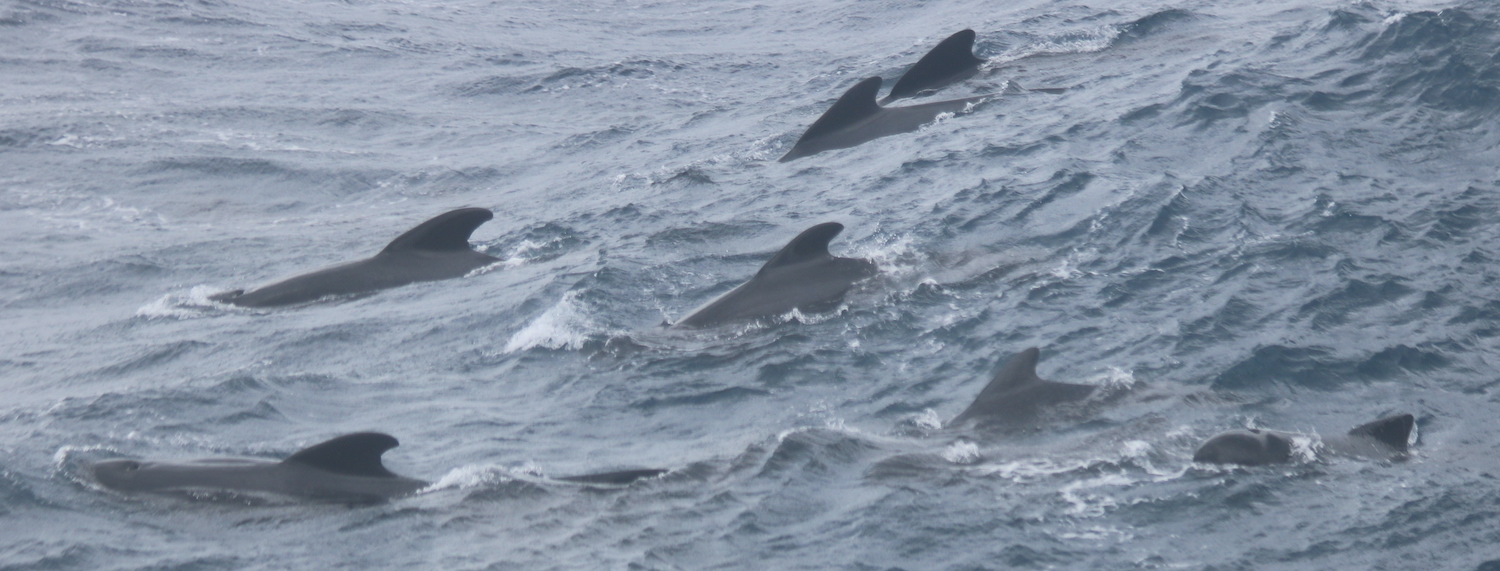
Tuesday September 12.
We finished the DASI tow in the wee hours and recovered it a first light, moving on to instrument recoveries. The Scripps instruments
rise at 20 meters per minute, so from 4,800 m water depth it takes 4 hours to reach the surface after release. Because of this we would normally
release 4 instruments an hour apart in batches. The OBS instruments have
new electrode arms and some extra buoyancy so it is unknown how fast they will rise - we took bets on this. They rise too fast! They only
take two and a half hours to rise, allowing only two of the Scripps instruments to be released. Ironically, this will slow our recovery
down.
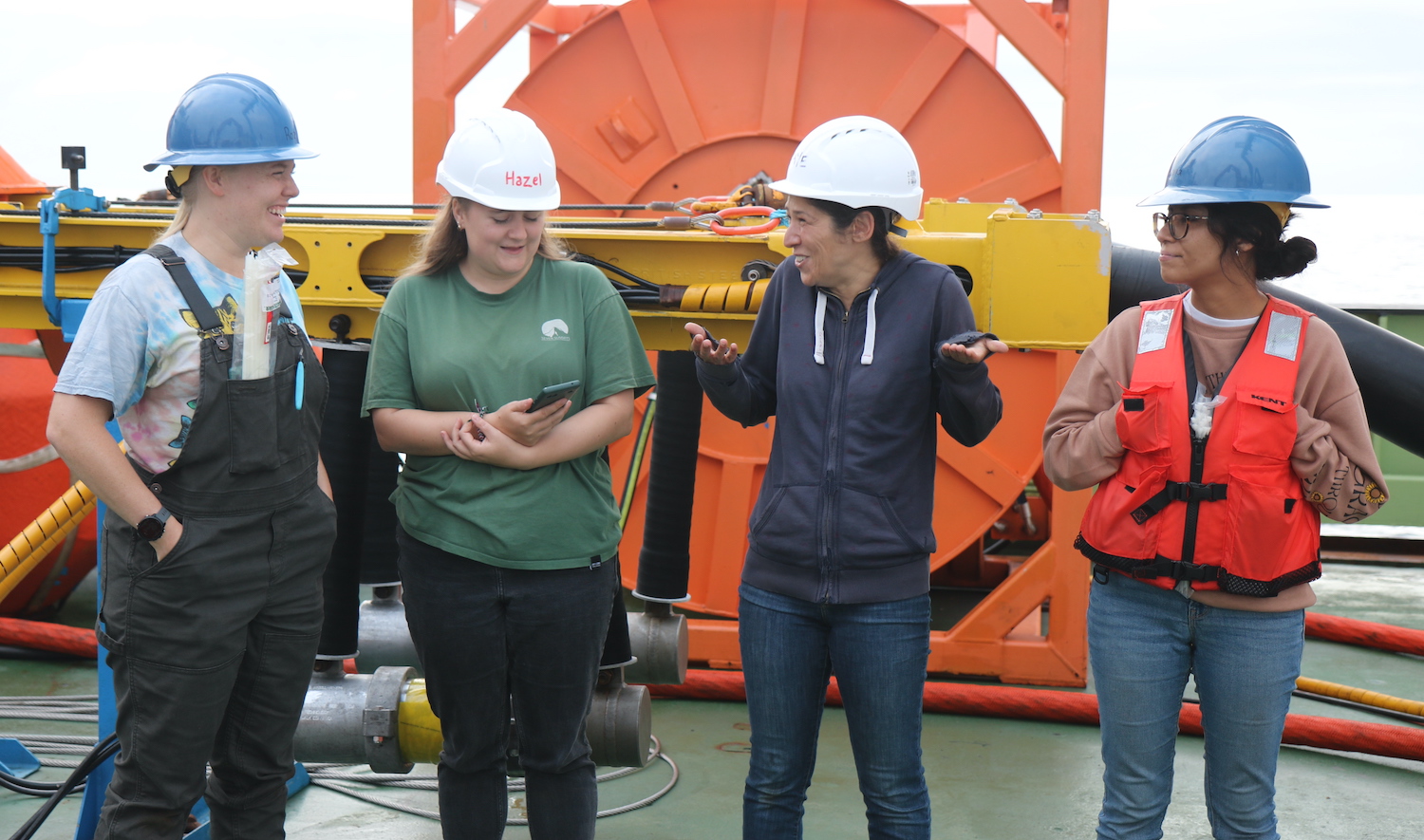
Roz, Hazel, Gaye, and Eliana discussing deep, meaningful points of science.
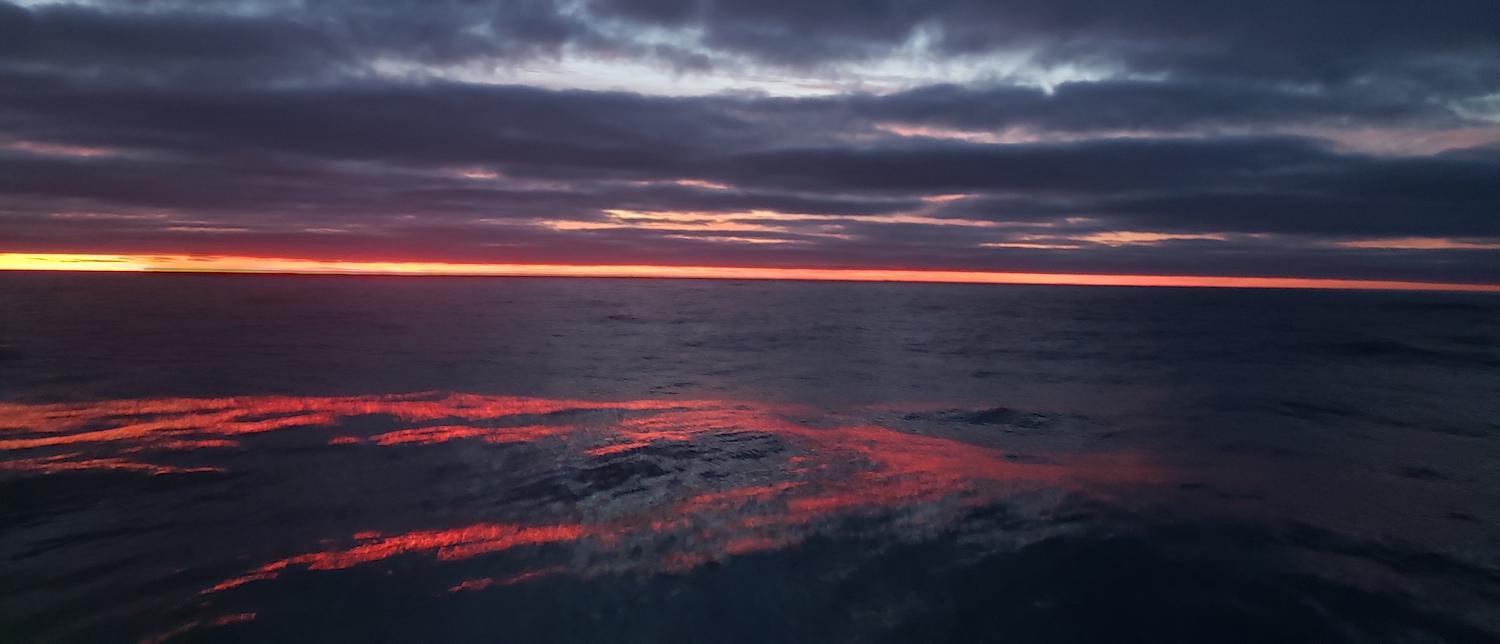
Eliana took this sunset photo early in the cruise.
Sunday September 10.
DASI just keeps on stuffing out the current. Weather is still very good, so it is
easy for the ship to hold the line. Things are looking so good that Gaye is starting to succumb to data lust,
working out how many stations we could deploy on the second line with the remaining ship time.
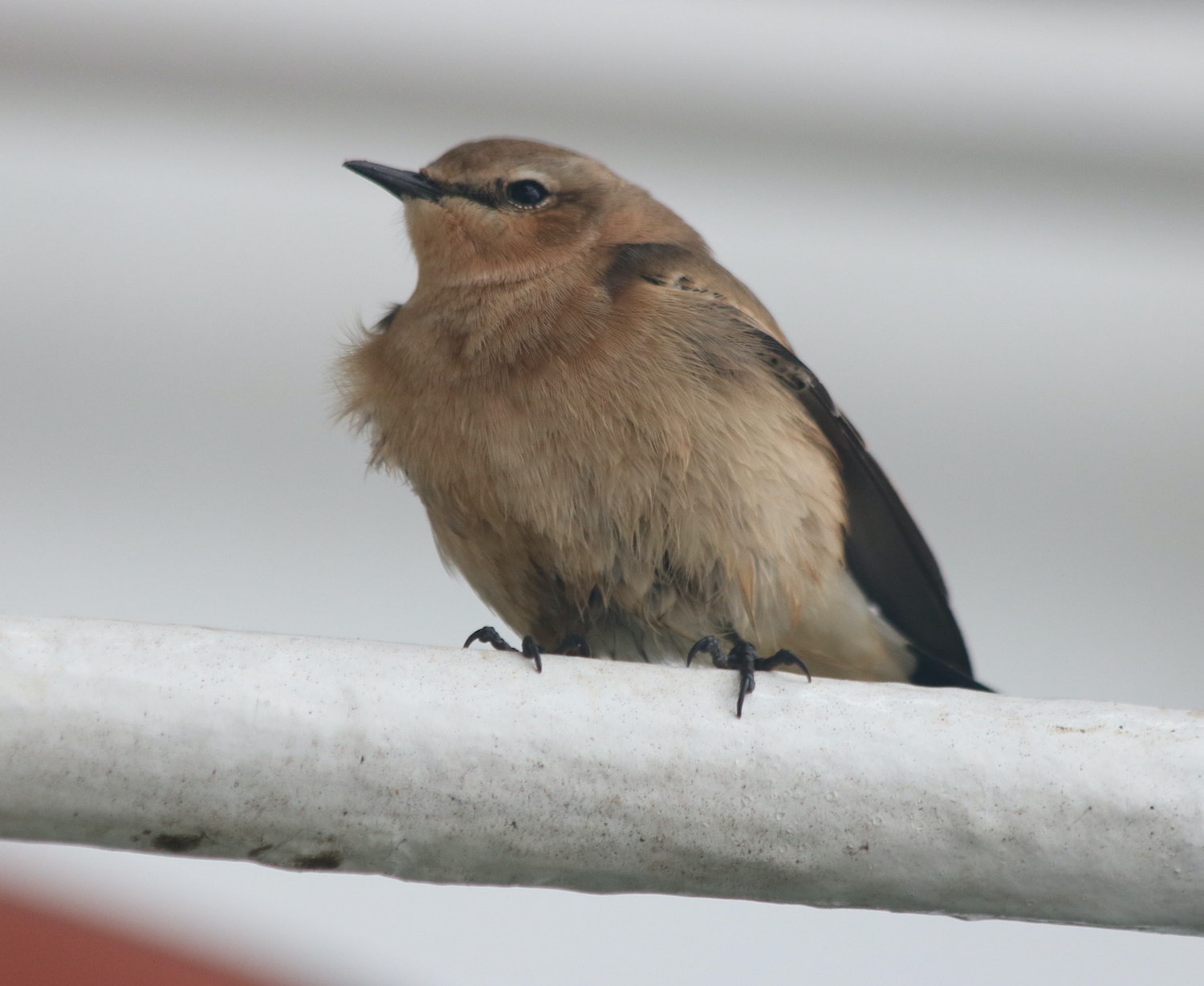
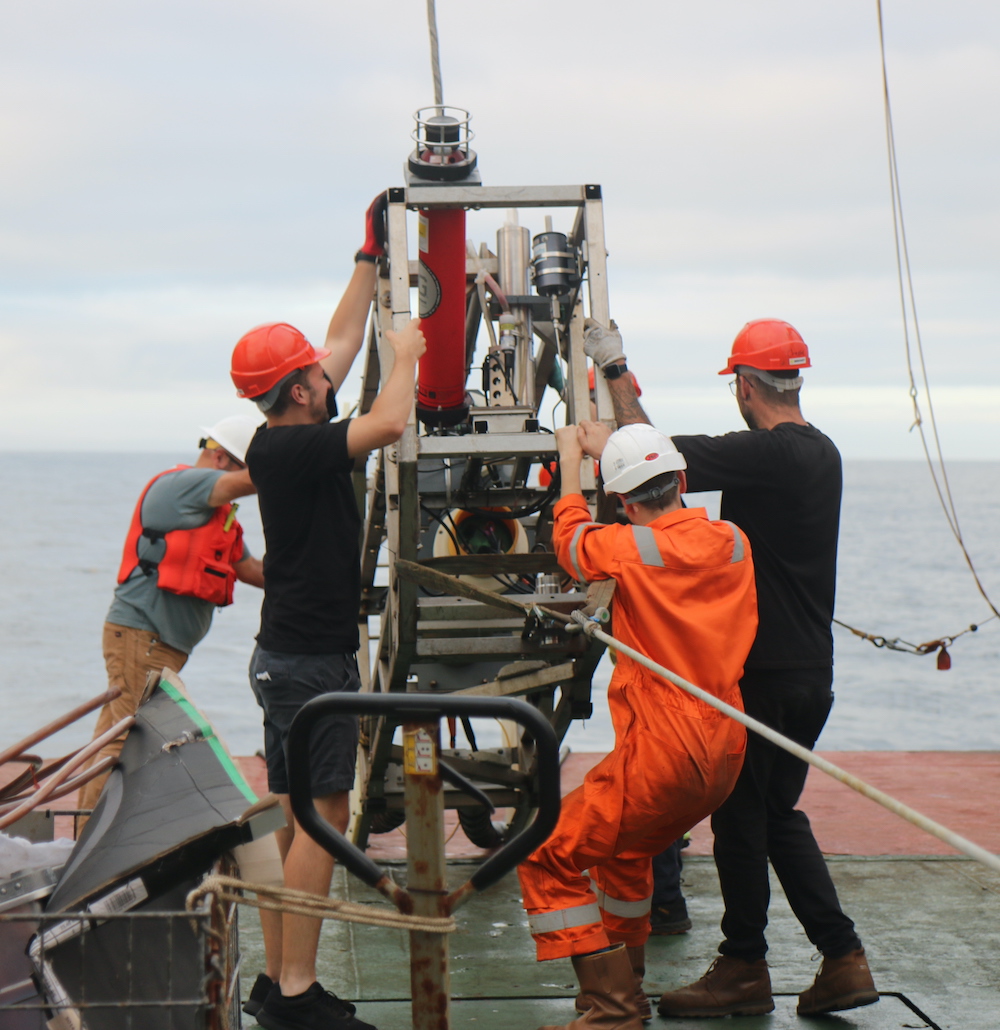
Tag lines? Who needs tag lines?
We often see birds on the ship, blown out to sea by storms. They are often in a sorry state of exhaustion, but
this little fellow is quite chirpy. Maybe it stowed away from the start rather than arrived by wind. Someone has
put out some food and water for it.
Saturday September 9.
After staying up late to see DASI deployed, I had a good night's sleep and got up this morning in time
for the captain's 8:30 am toolbox meeting. With great trepidation I walked into the main lab but was relieved to see the
transmitter waveform scrolling across the screen of the DASI control station. We are flying across the
abyssal plain at an altitude of 100 m stuffing out the current with not much to do other than tweak the winch in and out to stay at
that height. As the lab T-shirt says, boring is good.
Friday September 8.
The weather has settled down quite a bit overnight and we started recovering the airguns at breakfast time. We have
quite a transit to the start of the DASI tow because we've been heading north all night at 5 knots, but we are hoping to
get DASI in after dinner (have you noticed that time on a ship is measured entirely by eating?). I hope we
do -- the memory cards on the Scripps seafloor instruments fill up around mid-day on the 12th and the DASI tow is about 3 days, so if we don't get
DASI in soon we will have to recover and re-deploy our instruments first, dashing any hope of deploying them
on the second line.
Stay tuned ... it is not yet lunchtime.
DASI WORKS!! We deployed it after dinner as planned, and after an hour or two of nail-biting drama we are at
depth and transmitting 110 amps on the new 300 m antenna. Laurence and Hayden discovered that DASI does not
work at a topside voltage of 1600 VAC (too much back EMF from the switching) or 1500 VAC (not enough power for
the control circuitry), but 1500 VAC is Goldilocks. The topside power supply overheated and shut down, but the
Chief Engineer provided some big fans to help keep it cool. And the altimeter has the annoying habit of triggering
on old pings, making you think you are about to hit the seafloor when you are still 200 m above it. Maybe we are
living on a knife edge, but right now all is good, very good.
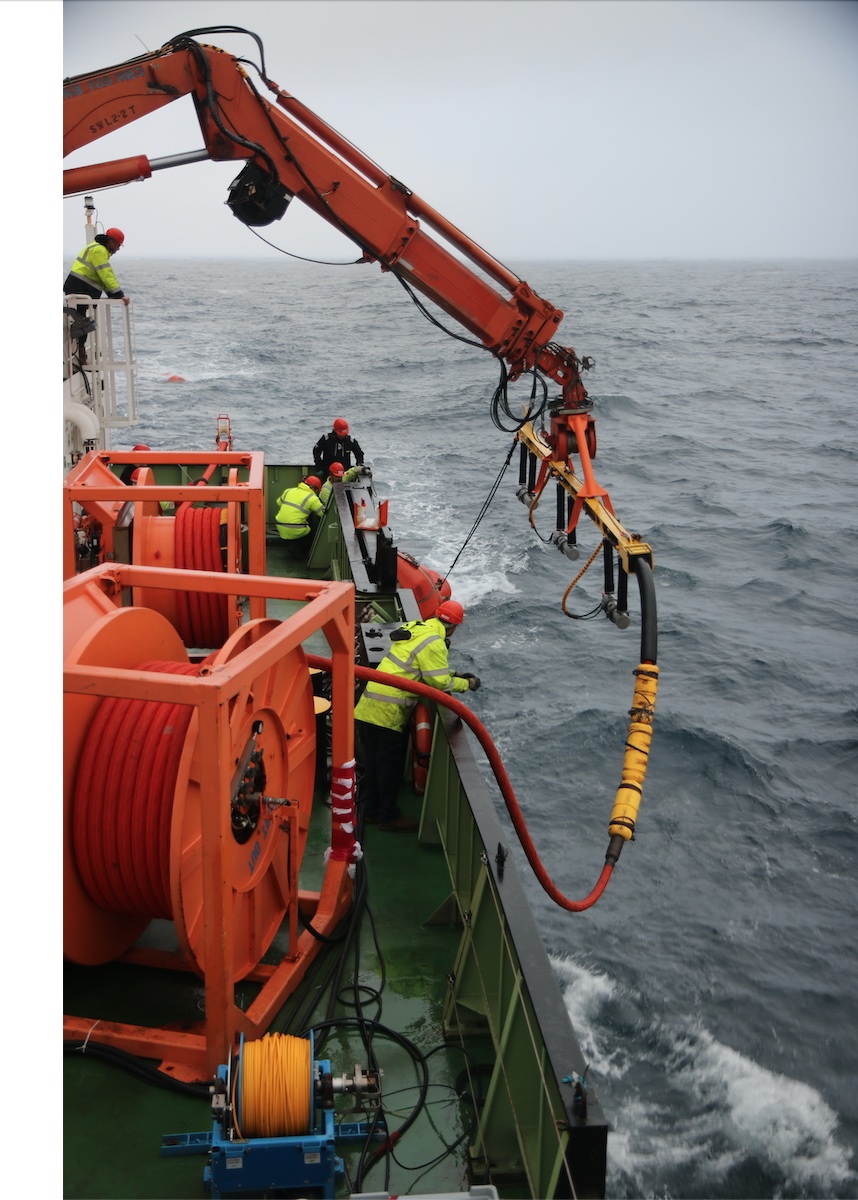
Thursday September 7.
Today started very well. Laurence and Hayden had replaced a fuse in DASI last night and right after breakfast we mounted it
back in the launch frame and ran a successful high voltage test. The weather was really no different from yesterday -- that is,
quite good -- so the plan was to recover the airguns and deploy DASI. No such luck... Within about an hour the weather was the worst we've seen
it on this cruise. The wind picked up to about 30 knots and the waves built to 3-4 meters over the morning, as promised by the weather
people. We decided that the risk of someone getting hurt while recovering the airguns was just too high, and in any case the
weather was probably too bad to deploy DASI. So we rode it out, first heading into the wind and then turning around to head north
"downhill" with the wind behind us, which gives a smoother ride (but a wetter deck).
Airguns weathering the conditions: The skinny yellow cable is for the magnetometer, which has flooded with water but can't yet be
brought in past the airguns.
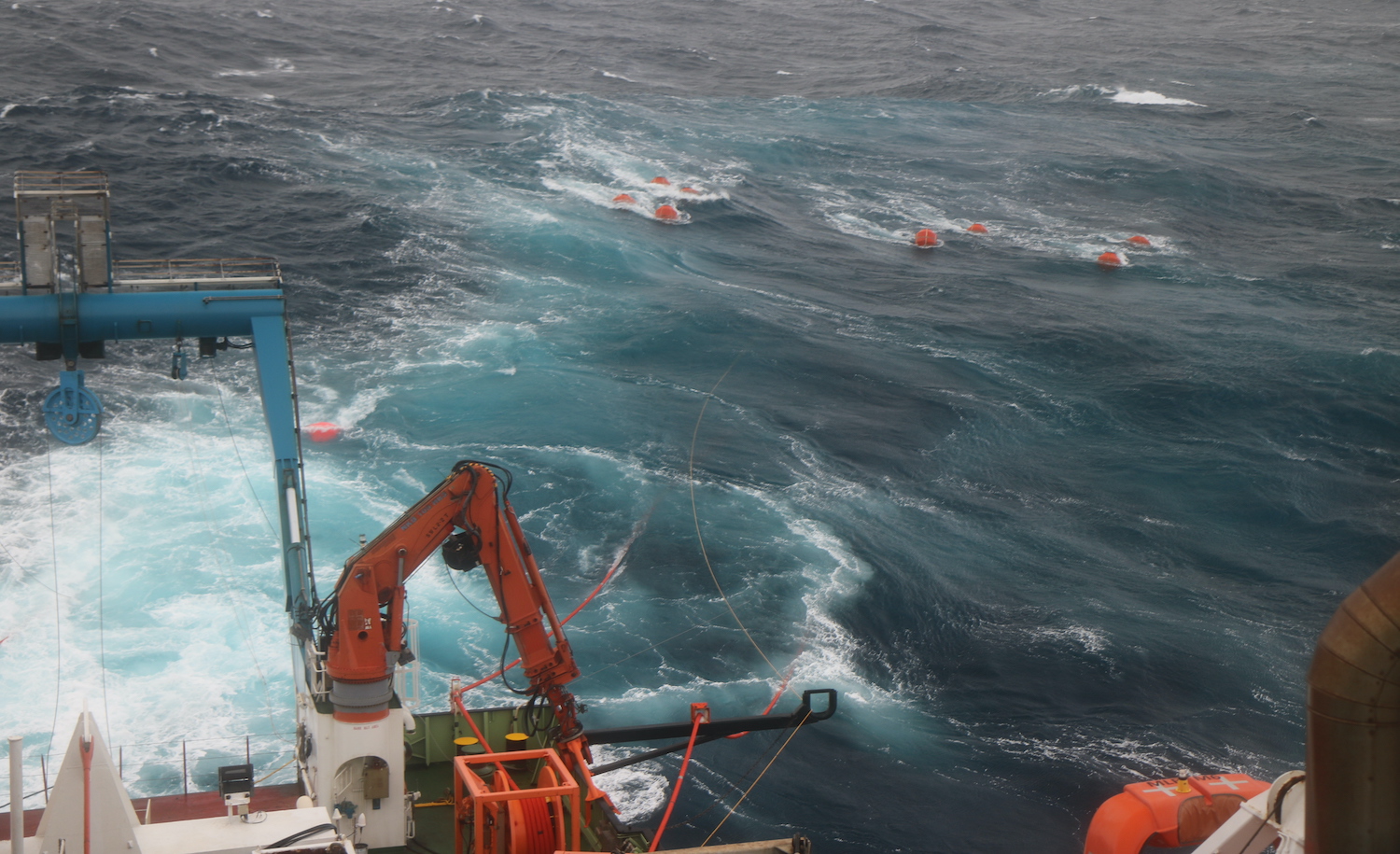
Wednesday September 6.
We are running the line towards the southwest with the airguns firing every 30 seconds. Hayden and Laurence continue to work on DASI.
The main topic of conversation is the weather forecast for tomorrow. A low pressure system is developing just to the southwest
of our line and 20-30 knot winds and 3-4 meter seas are predicted, starting tomorrow morning and developing throughout the day. We've
had pretty good weather up to now, but this is, after all, the North Atlantic (although looking at the ship's chart it is much more
fun to say that our line extends from the Pendragon Escarpment to the Porcupine Abyssal Plain).
Gaye looking very pleased with all the seismic data we are collecting:
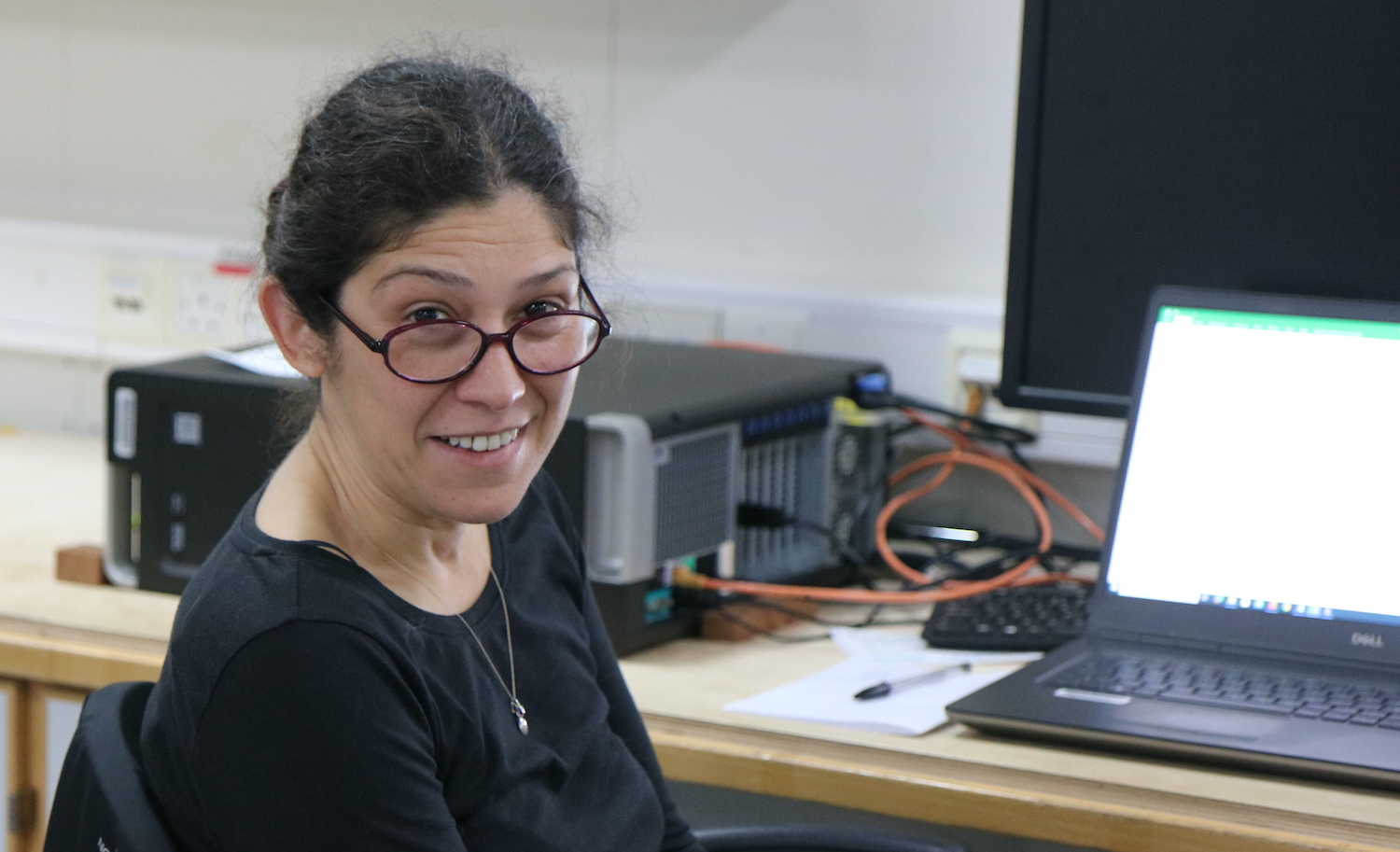
Tuesday September 5.
The airguns are firing away as we go down the line of seafloor instruments. DASI was tested again and more connections (ethernet this time) were fixed,
and we put it back in the launch frame for high voltage deck tests after dinner. I am optimistic that things will now work because Laurence has
drawn rather cute looking eyes on the pressure case. As followers of our lab know, both our SUESI instruments have a sort of smiley face
on them. This started with some students on the 2006 Loihi Seamount cruise (see "Tropical SUESI" in the photo album for that cruise), who
decked SUESI out with a hard hat, a face, a pineapple, and an umbrella drink while the ship was tied up waiting to sail.
All well and good and I rolled with it, leaving the face on (but disposing of the pineapple and drink). When we built the second SUESI
it did not work until we put a face on it, so nowadays faces are considered essential for our instruments (see LEM Launcher story below).
Well, the eyes might have worked on DASI but voltage on the topside high voltage power system is swinging wildly. More bad connections
are suspected and it is clear that we are not deploying DASI today. Gaye is going to re-run the seismic line at a smaller shot
spacing and lower airgun volume to collect a different sort of seismic data, which will give the DASI team another day or so to work on fixing
things.
Roz has a cabin just above the water line right by where we are deploying instruments. I have not posted any
instrument deployment photos yet. Once when I was taking photos of a deployment someone asked me why I was continuing to do so,
since I have hundreds of them already. I still take them, but yes, I am less motivated than I used to be. But this
night deployment photo from Roz is really pretty, and unlike anything I have taken before.
DASI eye:
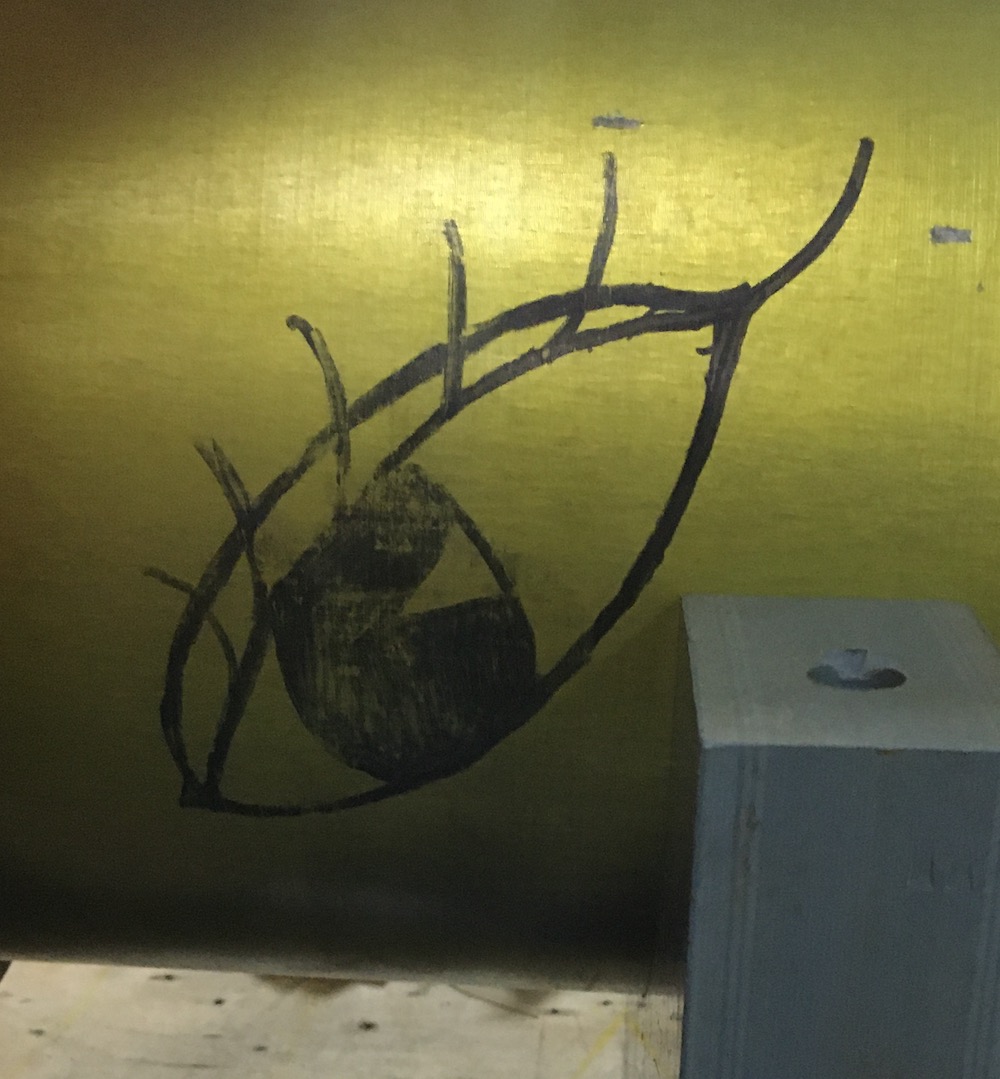
Monday September 4.
The airguns too are not without their problems, and we had to bring the two outer booms aboard to fix o-rings etc. But now we are
up and running with most of the guns working and heading down the line of instruments blasting away. Actually, even though
this is a big airgun array, the noise is quite muffled by the time it reaches the ship, especially on the decks above water. Meanwhile
Laurence and Hayden are making progress on DASI and we are cautiously optimistic that we will be able to deck test tomorrow and
perhaps even deploy in the evening when the seismic line is finished. The ADC circuit is not broken and many of the problems
seem to be associated with poor connections, including that of the fiber optic communication system. SUESI uses a slow, very old
fashioned, perhaps it would be fair to call primitive, communication system (9600 baud bi-directional FSK overlain on the 2000 VAC power
co-ax, for those who care), but it has proved robust. Most modern gear uses the fiber optic lines built into the more recent
deep-tow cables. This is nicely separated from the 2000 VAC power and offers very high speed communication, but is somewhat
delicate. Every connection has a signal loss, the end of the cable needs an oil bath to separate the fiber from the power
conductors (see LEM launcher story below), the slip rings on the winch are more complicated, etc. I have successfully used fiber
on SUESI, but very much prefer not to.
Laurence, Hayden, and DASI:
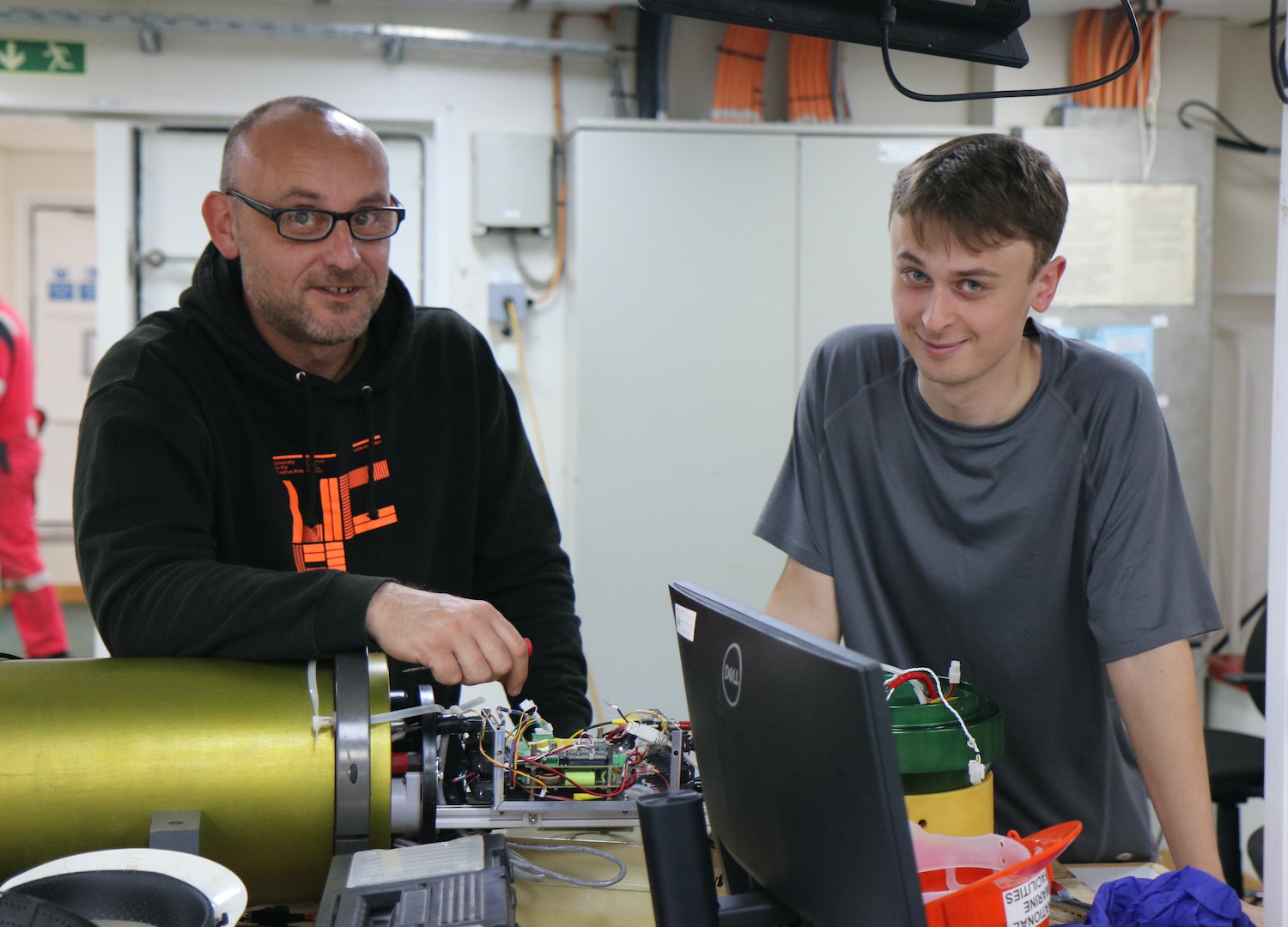
Sunday September 3.
DASI is proving to be a troublesome instrument. The first easy fix went as planned, but then we had some overheating problems
with the winch and then more trouble with DASI, and we ended up pulling it in and out of the water 3 times.
The last rebuild resulted in a quite complicated instrument which is being run more by software than hardware. Right now it
refuses to transmit current into the water because there is an error code being reported by an ADC circuit that measures
the output current. There are several ways to estimate the output current, so I would be happy just to have current. DASI
doesn't seem to see things that way ("I'm sorry Steve, I'm afraid I can't do that"). Someone said that instruments need to
be more "agricultural" (you should be able to fix them using a wrench).
After the last recovery we decided to give Hayden and Laurence, who are the DASI experts, more time to tinker, and
move on to the seismic part of the experiment. We need to deploy the airguns before dark, so that we can look around
and make sure there are no marine mammals (aka whales) in the area before we start shooting. Deploying airguns always
seems like a big deal to me, and this was no exception, with about 10 people on deck working to deploy 4 booms each with
3 guns, and another 2 guns deployed off the fantail. It all seemed to go smoothly and before dark we were testing the guns.
With nothing more to see the Scripps team retired to the bar and Jake taught Roz and Eliana how to play darts. It was
interesting to watch as I indulged in a single glass of Malbec (not quite a rum ration, but the UK ships have managed to
hold on to the tradition of keeping a bar open on the research vessels).

Saturday September 2.
The 1 am call from Chris came as expected and we set to work. The night shift had prepared the LEM instrument so it was just
a matter of deploying the antenna and launcher. Much less stressful than before, since we knew the communication system
was working, but still tedious, especially in the deeper water at the southern end of the line (4800 m) which means we have
to pay out over 6,000 m of tow cable. All went well and we were
done by breakfast.
The Southampton transmitter is called DASI, or Deep-towed Active Source Instrument. The first version of DASI
was built by Martin Sinha in Cambridge in the late 1980's, and was based on the first Scripps transmitter built by Chip Cox,
my mentor and predecessor. Martin later moved to Southampton with DASI, and it has been re-built a couple of times since then (the
modern Scripps transmitter name, SUESI, Scripps Undersea Electromagnetic Source Instrument, was a play on the DASI name).
If you are interested in the early marine EM history I wrote
an article about it from my perspective.
The current DASI is a comprehensive rebuild that was done before Covid, and hasn't yet been tested in the water because
the pandemic made a mess of research vessel operations. It also uses a new antenna that we built at Scripps to replace
the original Cambridge one, which used an oil-filled tube to lift a heavy copper cable. The Scripps antennas use a lighter
aluminum conductor floated by plastic.
I stayed up to help with the deployment, which went very well. The weather had indeed improved a lot, and we hardly needed
the tag lines during the deployment:
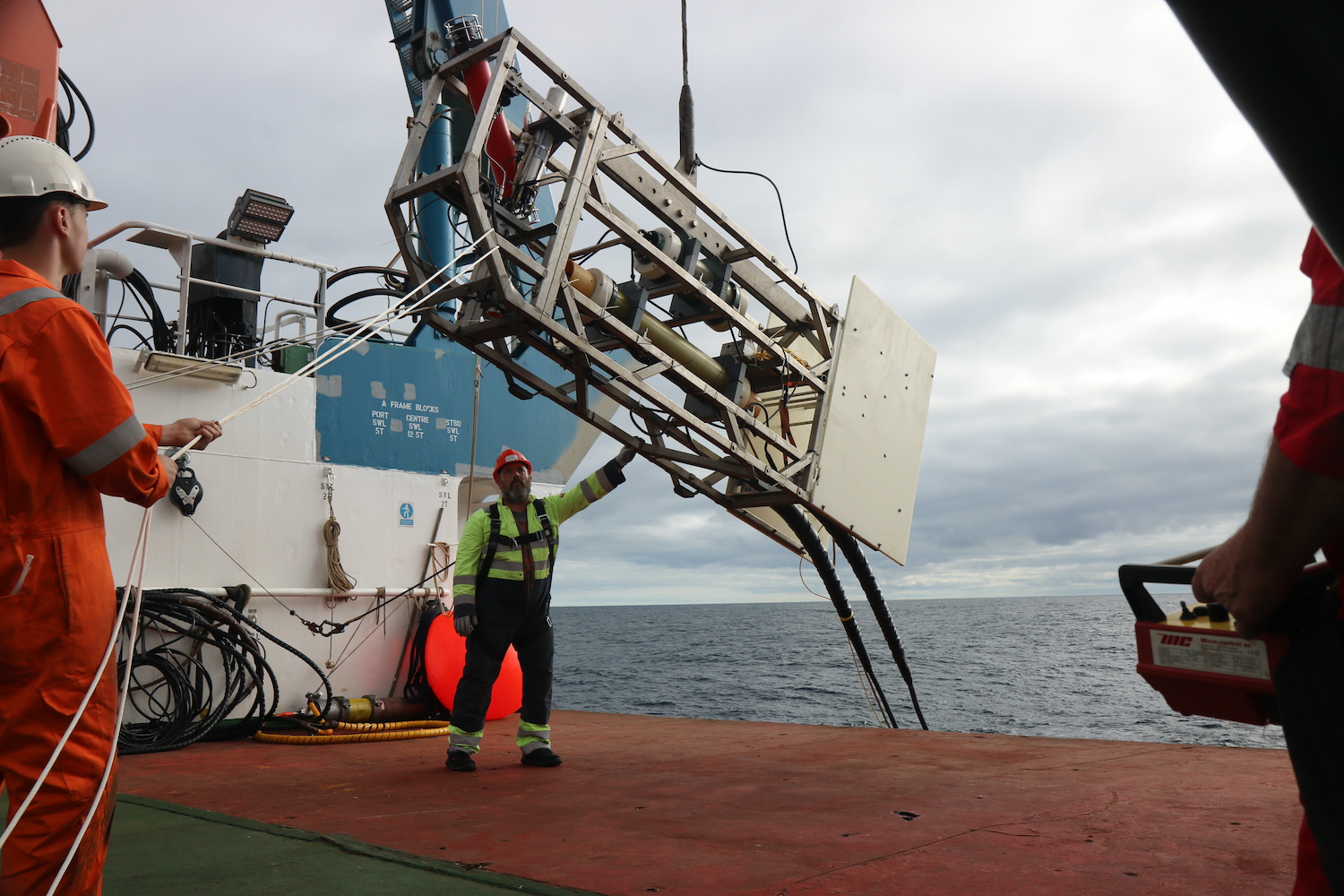
Around dinner time we lowered DASI into the water and started tests. Unfortunately the tests failed and plans were made to bring her back
aboard and make the fix, which was predicted to be fairly simple. By now I had been working a very long
day, and decided it was time to get some sleep. There is nothing I can do anyway - the Scripps antenna was in the water and
could stay there during the fix.
Friday September 1.
We continue to deploy the seafloor instruments, which is going very well, even though the weather has picked up and
making things a little more challenging. There are well developed white caps, 25-28 knot winds, and a 2-3 m swell,
which is by far not the worst the North Atlantic can throw at you, but not the best either. But the ship rides well and the roll stabilization system seems to do its job. Our
plan was to deploy the second LEM near the southern end of the line around dinner time, but we are concerned that the weather
is a little too rough to do this without damaging equipment. The launcher is built to take a beating, but we are sharing the
deep-tow cable with the EM transmitter, which uses an oil-compensated box to terminate the fiber optic cables that the transmitter
uses (we are only using the copper conductors for the LEM launch system). The termination box is mounted on the tail of the LEM launcher
and could be damaged if the launcher swings badly during recovery, which it tends to do without the LEM's antenna to stabilize
it. This would be game over for the controlled-source EM (CSEM) part of the project, which relies on the EM transmitter. So,
we've decided to leave the LEM launch until after all the other seafloor instruments are deployed, since the weather is forecast to
improve significantly overnight, but this means I have to get up at
around 1 am for the start of the deployment. Time to get some sleep ...
Thursday August 31.
We arrived on station in the morning and immediately got to work deploying instruments. The weather is still
good and we deployed 2 OBS and 4 OBEM instruments by early afternoon. The next order of the day was to deploy
a "LEM", an instrument with a long (200 m) antenna that is towed down to the seafloor using a "LEM launcher".
I have been deploying LEMs ever since I started working at Scripps with Chip Cox 40 years ago, but we don't do
it very often and for this cruise we have a brand new communication system that allows the LEM launcher to
send depth and altitude up the tow cable to the ship. The idea is that the launcher lets go of the LEM when it is
about 10 m above the seafloor. This is real nail biting stuff since it takes about 3 hours
to tow the LEM down to the seafloor and if it doesn't let go it is all a waste of time. But after a few hiccups
the new communication system worked well and we were successful. Back to OBEM and OBS deployments.
Anyone who follows our blogs will know that our EM transmitters, the SUESIs, have a smily face. Our new students,
Eliana and Kyle, decided that the LEM launcher needed a face too. It is hard to tell if Jake approves or not ...
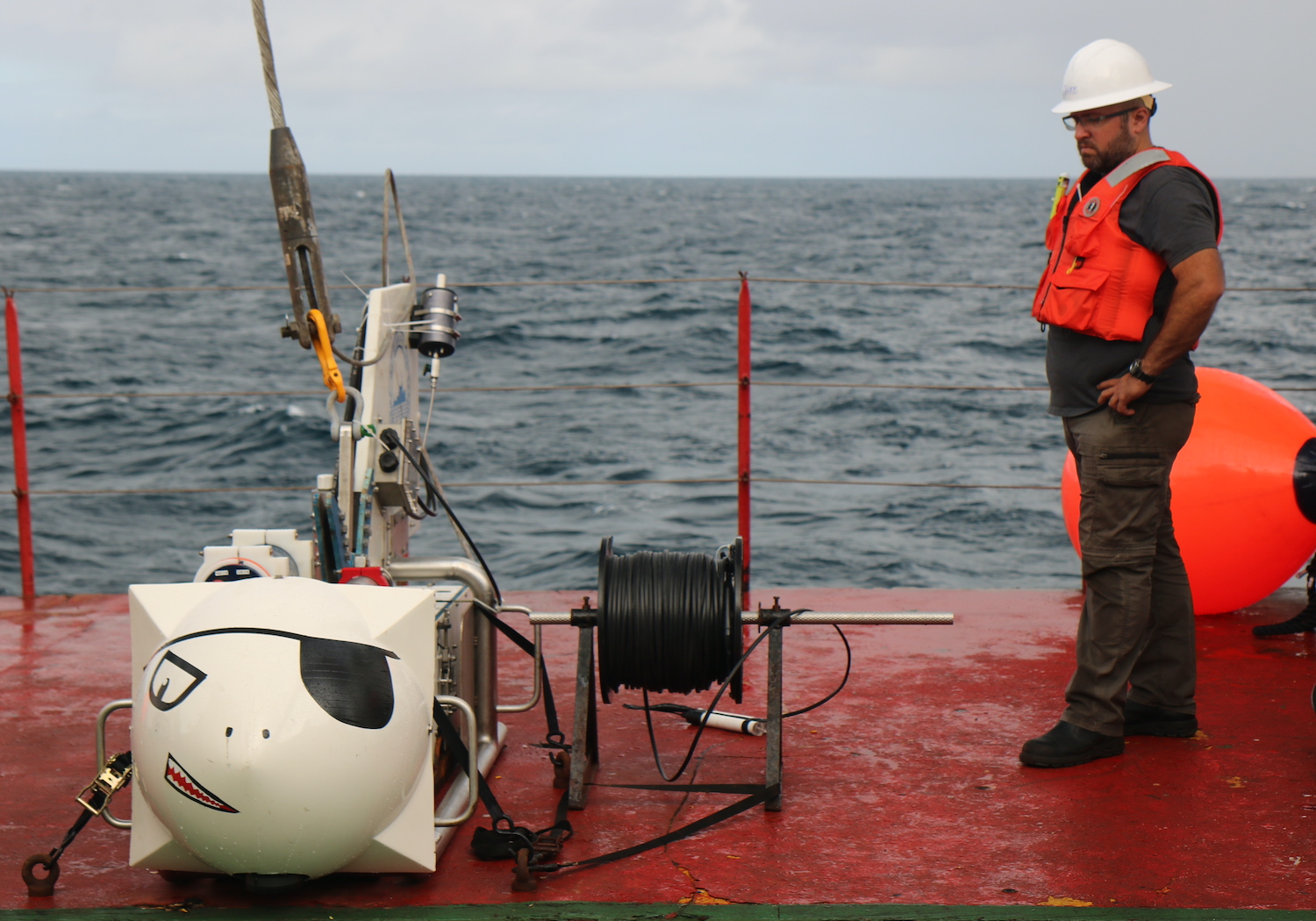
Wednesday August 30.
Off and sailing! And how... I always suspected that research vessels had an extra engine that
they didn't tell the scientists about. Now I know it is true. They are running the "third engine" and we
are doing as much as 17 knots to make up some lost time. Yes - 17 knots. Fortunately the weather is good so we're not
hammering into waves. We've done as much as we can to prepare our instruments and will be on station early
tomorrow morning. Wish us luck...
Tuesday August 29.
More gnashing of teeth and pulling of hair this morning and then good news mid-afternoon. We can keep
the export license gods happy by sacrificing some non-essential equipment and leaving it behind. We sail at 9 pm.
Monday August 28.
We were hoping to sail this morning but have been delayed by paperwork required for export licenses
(we are working in Irish waters).
It doesn't help that today is a "bank holiday", so nothing is open. Well, nothing except the pubs,
so that's some consolation that quite a few of us took advantage of this evening in lieu of sailing.
The jolly James Cook, the vessel we are all hoping to sail on one day:
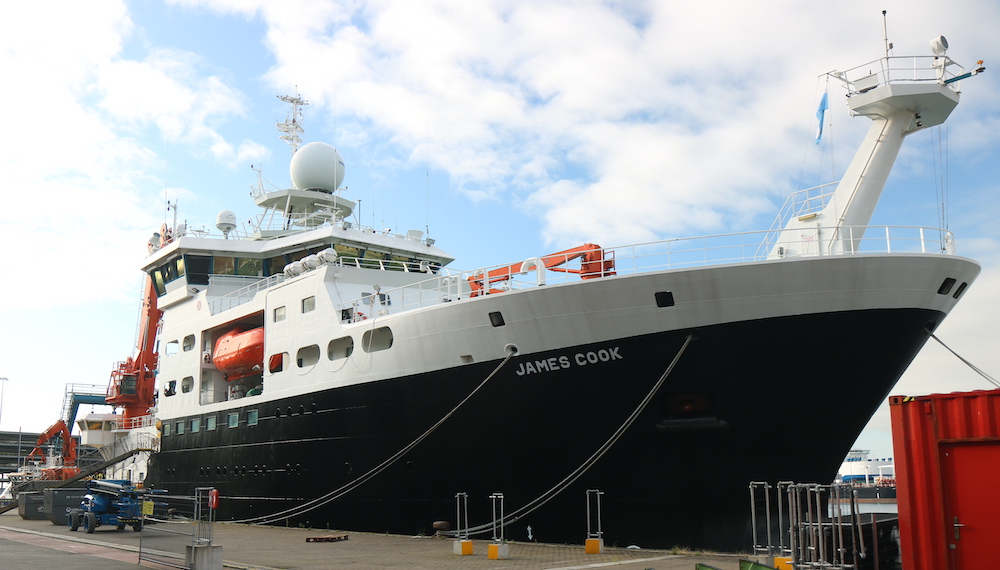
|